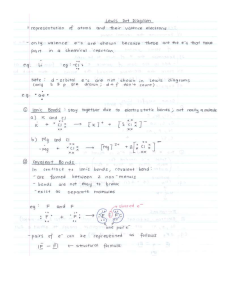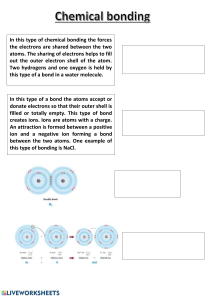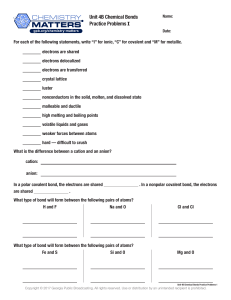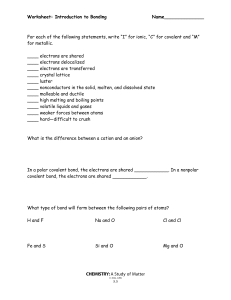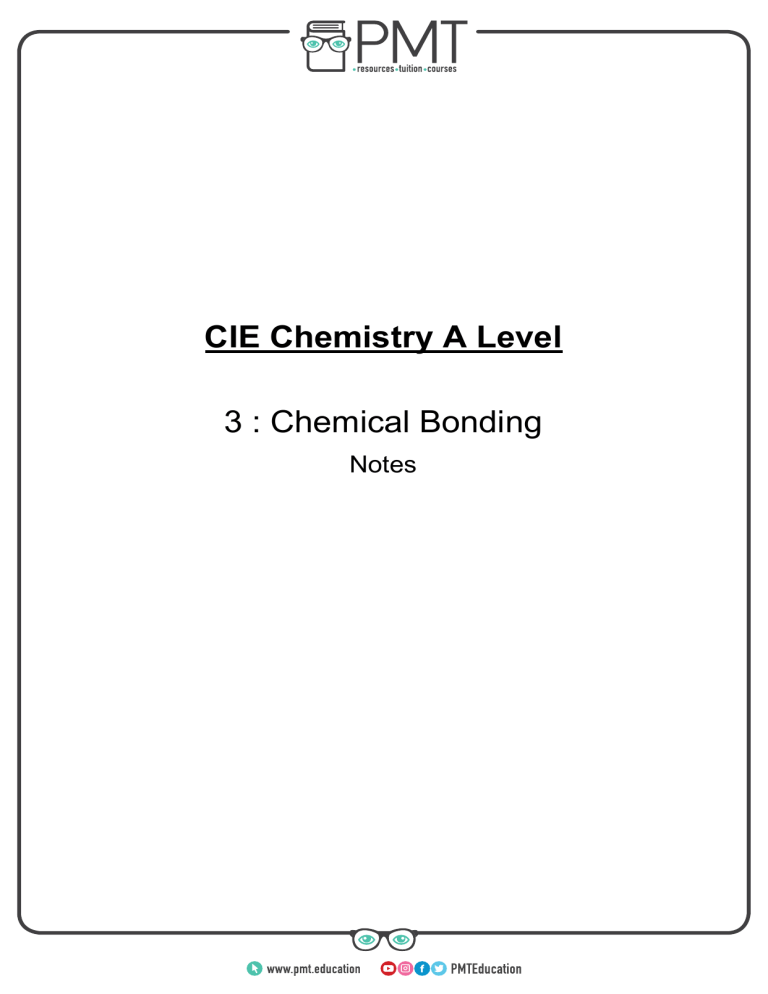
CIE Chemistry A Level 3 : Chemical Bonding Notes www.pmt.education Ionic Bonding An ionic bond is formed when electrons are transferred from a metal to a non-metal, forming an ionic compound. The compound is held together by the electrostatic attraction between the positively charged metal ions and negatively charged non-metal ions. Dot and cross diagrams are often used to represent ionic bonding. For one species electrons are shown as dots and the other as crosses. Typically only outer shell electrons are shown and charges are shown outside square brackets surrounding the ion. Compound Ions Formation of ions Sodium chloride (NaCl) Na+ and Cl- Na donates an electron to Cl Magnesium oxide (MgO) Mg2+ and O2- Mg donates 2 electrons to O Calcium fluoride (CaF2) Ca2+ and F- Ca donates 2 electrons to 2 F Dot and cross diagram In ionic compounds, ions are surrounded on all sides by oppositely charged ions forming a giant ionic lattice. Covalent bonding A covalent bond is a chemical bond where electron pairs are shared between atoms. A covalent bond is the strong electrostatic attraction between a shared pair of electrons and the nuclei of the bonding atoms. This is because the negative electrons are attracted to the positive protons in the nuclei and this overcome the repulsion between the two nuclei. Similarly to ionic bonding, dot and cross diagrams can be used to represent covalent bonding. The circles (or outer shells) must overlap and this overlap must contain a dot and cross to represent the shared pair of electrons. Below are examples of covalent compounds: www.pmt.education Compound Dot and cross diagram Compound Hydrogen (H2) Oxygen (O2) Hydrogen chloride (HCl) Carbon dioxide (CO2) Methane (CH4) Ethene (C2H4) Dot and cross diagram Coordinate (dative covalent) bonding A dative covalent bond has one atom which supplies both of the shared electrons. In the dative covalent bond A→B, A donates a pair of electrons to B. Examples are shown below: Compound Dot and cross diagram Ammonium ion (NH4+) Al2Cl6 ‘Coordinate (dative covalent) bonding’, Chemguide www.pmt.education Sigma Bond (𝜎) A sigma bond is a single covalent bond formed when two orbitals overlap end-to-end. The pair of electrons are found between the two nuclei. Below is a diagram showing the electrons in the second shell of carbon: Carbon forms 4 covalent bonds rather than 2 because this releases more energy and makes the molecule more stable. A small amount of energy is used to promote one of the 2s electrons to the empty 2p orbital (as these have a similar energy) to give 4 unpaired electrons. The carbon atom is now in an excited state. Hybridisation occurs when the electrons are rearranged again into four identical sp3 hybrids. The sigma bond forms when two orbitals from different atoms overlap end-to-end. The process of promoting an electron, hybridisation and formation of the molecular orbitals follows the same pattern in all covalently-bound molecules. Pi Bond (π) A pi bond is a covalent bond formed when 2 orbitals overlap sideways. The pi bond is the region above and below a sigma bond where this pair of electrons can be found. When a pi bond forms between two carbons, first a 2s electron is promoted to the empty 2p orbital to give 4 unpaired electrons. The carbon atom is now in an excited state. Hybridisation of three orbitals (rather than 4 when forming a sigma bond) forms sp2 hybrids. End-to-end overlap of two sp2 hybrids from different carbon atoms forms a sigma bond. The p orbital in each carbon contains an unpaired electron. These orbitals overlap sideways to form a pi bond. Shapes of molecules The shape of a molecule is determined by the arrangement of electrons around the central atom. Electron pairs are regions of negative charge so they repel each other and arrange themselves as far apart as possible. Lone pairs offer more repulsion than bonding pairs so the order of repulsion is: Greatest repulsion Lone pair - lone pair Lone pair - bonding pair Lowest repulsion Bonding pair - bonding pair When drawing the shapes of molecules, a bond in the plane of the paper is a normal line. A bold wedge shows the bond is coming towards you and a dotted wedge shows the bond is going away from you. Dots are used to represent electrons in a lone pair. www.pmt.education The shape of molecules are shown in the table below: Number of lone pairs (lp) and bonding pairs (bp) Shape name Bond angle Example compound and diagram 2 bp Linear 180° CO2 3 bp Trigonal planar 120° BF3 4 bp Tetrahedral 109.5° CH4 5 bp Trigonal bipyramidal 90° and 120° PF5 6 bp Octahedral 90° SF6 2 bp, 2 lp Non-linear or V-shaped 104.5° H2O 3 bp, 1 lp Pyramidal 107° NH3 www.pmt.education Ions have the same shapes and bond angles as molecules. For example, the ammonium ion (NH4+) has 4 bonding pairs so has a tetrahedral shape and a bond angle of 109.5°. Intermolecular forces Intermolecular forces of attraction occur between neighbouring molecules. Electronegativity Electronegativity is the ability of an atom to attract a bonding pair of electrons in a covalent bond. Electronegativity increases towards the top right of the periodic table. More electronegative atoms are better at attracting the bonding electrons in a covalent bond. A polar bond is a bond with a permanent charge difference (or permanent dipole). This occurs when the two bonding atoms in a covalent bond are different because one atom is more electronegative than the other so it will attract the bonding electrons towards itself. If two atoms in a covalent bond are exactly the same, the electronegativity of both atoms will be the same so the bond will be non-polar. A polar molecule must contain polar bonds and be non-symmetrical. If a polar molecule is symmetrical, the dipoles will cancel each other out. The oxygen in non-metal oxides is very electronegative. This causes a permanent dipole across the covalent bond so the atom that oxygen is bonded to becomes partially positive. When the oxide is added to water, lone pairs on oxygen in the water are attracted to the partially positive atom in the oxide causing hydrolysis. Below are examples of this reaction: P2O5(s) + 3H2O(l) → 2H3PO4(aq) Cl2O(g) + H2O(l) → 2HClO(aq) Hydrogen bonding Molecules containing N-H, O-H or F-H bonds can form hydrogen bonds. This is because oxygen, nitrogen and fluorine are very electronegative meaning they draw the bonding electrons towards them to create a strong dipole (a charge difference across the bond). A hydrogen bond is the attraction between the partially positive hydrogen (Hᵟ+) and a lone pair on Oᵟ-, Nᵟ-, or Fᵟ-. Water (H2O) and ammonia (NH3) are examples of compounds that form hydrogen bonds: www.pmt.education Reactivity The reactivity of covalent compound is affected by three factors: ● Bond energy: the amount of energy needed to break one mole of a given gaseous covalent bond to produce gaseous atoms. Bond energies given in the data book are an average and don’t consider the specific molecule the bond is found in. ● Bond length: the distance between two nuclei in a covalent bond. A longer bond means the shared pair of electrons is further from at least one nucleus so the attraction and bond strength decreases with increasing bond length. ● Bond polarity: if the electronegativities of the bonding atoms are different, the bond will be polar and the bonding atoms will have partial charges. The strength of a bond rather than polarity typically determines the rate of a reaction. A stronger bond means the compound is less reactive. Polarity may mean molecules are attracted to each other which triggers the reaction. Van der Waals forces Dispersion forces, also known as London forces, are a type of van der Waals force found between symmetrical, non-polar molecules. There are no permanent dipoles but electrons are mobile and in an instant, they may be unevenly distributed. This creates a temporary dipole, with the side containing more electrons becoming partially negative. The temporary dipole can induce dipoles in neighbouring molecules as the partial negative charge repels electrons. These opposite partial charges will remain attracted to each other. Permanent dipole-dipole forces are another type of van der Waals forces found between polar molecules. The permanent dipole in these molecules means the partial charges are more strongly attracted to one another. Molecules with permanent dipole-dipole forces usually have higher boiling points than those which only have London forces between them. However, CCl4 has a higher boiling point than CHCl3 because CCl4 is a bigger molecule with more electrons so the increased London forces compensate for the lack of permanent dipole-dipole forces. Elements in group 18 exist as single atoms so the only forces between the atoms are London forces. These forces are relatively weak so require little energy to break meaning group 18 elements have low boiling points. Boiling point increases down the group because the number of electrons and atomic radius increases meaning there are stronger temporary dipole and stronger London forces between the atoms. Br2 is liquid at room temperature because although it only has London forces between molecules, it contains lots of electrons meaning strong temporary dipoles between molecules. Metallic bonding In metals, positive metal ions (cations) are fixed in a lattice and surrounded by mobile delocalised electrons. The strong electrostatic attraction between the positive metal ions and negative electrons hold the metal together. www.pmt.education Bonding and physical properties The physical properties of a substance are affected by the types of bonding it contains: ● Covalent (giant structures only): ○ High melting and boiling points - strong covalent bonds require a large amount of energy to break. ○ Mostly non-conductors - don’t contain mobile charged particles (except graphite which contains delocalised electrons). ○ Insoluble - covalent bonds in the lattice are too strong to be broken. ● Ionic: ○ High melting and boiling points - strong electrostatic attraction between oppositely charged ions requires a lot of energy to break. ○ Electrical conductor - when aqueous or molten, the ions are free to move and conduct electricity. When solid, the ions are fixed in an ionic lattice so can’t conduct electricity. ○ Soluble in polar solvent - charged parts of the solvent are attracted to the oppositely charged ions. ● Metallic: ○ High melting and boiling point - the attraction between the ions and delocalised electrons is strong so a lot of energy is needed to overcome the metallic bonding. ○ Good electrical conductor - contains mobile delocalised electrons which can conduct electricity as a solid. ○ Malleable and ductile - the regular structure and delocalised electrons allow the uniform layers of ions to slide over one another. ● Hydrogen bonds: ○ High boiling point - The melting and boiling points are greater than those of molecule with only van der Waals forces between them because hydrogen bonds are stronger. ○ Soluble in water - strong permanent dipoles allow the formation of hydrogen bonds with water. ○ Non-conductors - no mobile charges so are unable to conduct electricity. ● Van der waals forces: ○ Low boiling point - forces are weak so require little energy to break. Larger molecules have more van der Waals forces so have higher melting and boiling points. ○ Solubility - unless they react with water, most molecular compounds are insoluble in water because they release too little energy when they dissolve. They are often soluble in organic solvents because they both contain van der Waals forces. ○ Non-conductors - no mobile charges so are unable to conduct electricity. The hydrogen bonding in water causes water molecules in ice to align in an open lattice structure. This means water expands as it freezes so ice is less dense than water. Energy changes and reactions During a chemical reaction, energy is required to break bonds and released when making bonds. An exothermic reaction is a reaction in which energy is released. This is because less energy is required to break bonds than is released when making bonds. An endothermic reaction is a reaction which takes in energy. This is because more energy is required to break bonds than is released when making bonds. www.pmt.education
